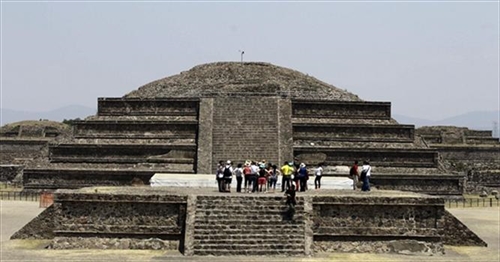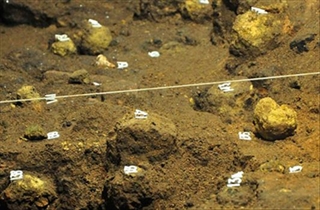 Temple of Quetzalcoatl
Temple of QuetzalcoatlThe Mesoamerican ruins of Teotihuacan
(4), represent one of the largest urban centers of the ancient world. Teotihuacan was thought to have been established around 100 BC, the pyramid-filled city had more than 100,000 people at it’s peak. It was abandoned for mysterious reasons around 700 AD. long. The Aztecs didn’t arrived till around 1300 AD. Teotihuacan is located just 30 miles from Mexico City.
The excavation of the temple of the Feathered Serpent, also known as the Temple of Quetzalcoatl
(1)(5), is a 6 level pyramid decorated with snake like features. The excavation of the temple focused on a 330 foot long tunnel which runs underneath the structure. The tunnel was discovered in 2003 when heavy rain uncovered a hole a few feet from the pyramid.
 Mysterious Spheres
Mysterious SpheresArchaeologist Sergio Gómez Chávez
(6) director to the Tlalocan Project, required several years of preliminary work and planning. Finally a few months ago they found two side chambers at 236 and 242 feet from the entrance, now called north and south chambers. The archaeologist exploring the tunnel, which was deliberately filled with debris form the Teotihuacan people, used a remote-controlled robot called Tlaloc II-TC
(2). Tlaloc II-TC has an infrared camera and a laser scanner that generates in 3D of the spaces beneath the temple.
The mysterious spheres
(3) lay in both north and south chambers. Ranging from 1.5 to 5 inches, the objects have a core of clay and are covered with a yellow material called Jarosite. This material is formed by the oxidation of pyrite, which is a metallic ore. In pre-hisispanic times the spheres would have looked metallic. Originally the spheres would have shown brilliantly. There are hundreds of these spheres in the South chamber.
 Sergio Gómez Chávez
Sergio Gómez ChávezI believe that high-ranking people, priest and even rulers, went down to the tunnel to perform rituals. The archaeologists found many offerings, including pottery and even wooden mask covered with inlaid rock crystal, jade and quartz, all dating from around 100 AD. Even the walls and ceiling of both chambers were covered with a mineral power containing magnetite, pyrite and hematite which provided a special brightness to the place.
The tunnel is in pristine condition, untouched for almost 2 millennia. “Can you imagine what could be found inside?” said Ng Tze Chuen, an independent researcher who worked on the design of the Tlaloc robot. Ng Tze Chuen helped create the Djedi robot that explored Egypt’s Great Pyramid in 2010, believes the tunnel might lead to one of the most significant archaeological finds in Teotihuacan.
The tunnel was sealed twice by the Teotihuacan people. Thick walls, were erected to block access, were demolished about 1,800 years ago to deposit something of great importance in the central chamber at the end of the tunnel. Chávez said, “ Maybe in this place we will find the remains of those who ruled Teotihuacan.”.